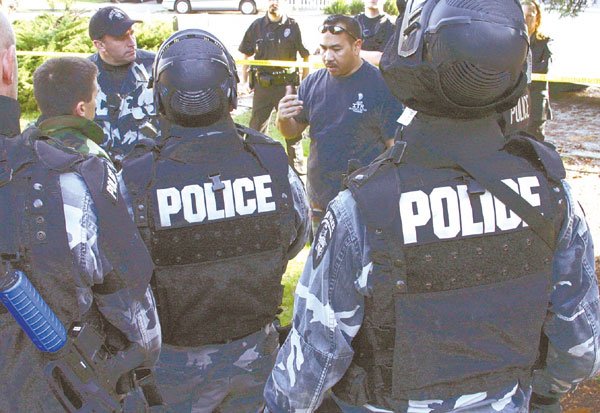Gilroy’s Special Operations Group trains for a multitude of
high-risk situations
– with teamwork being a key element to success
Gilroy – A masked woman sat strapped to a chair with a mock bomb tied to her, holding a sign reading: “Don’t touch me.” Squatting behind trash cans and in bushes, peering through holes in a fence, donning bullet proof vests and camouflage uniforms, members of the Gilroy Police Department’s Special Operations Group (SOG) trained using a series of simulated emergency scenarios Sunday afternoon.
The group utilized the empty homes on Miller Avenue slated for demolition later this year. In the past, they’ve trained on buses and trains, in attics and in open fields, learning how to secure them in case a disgruntled employee or armed suspect decide to take matters into their own hands.
“We try to cover everything we believe could happen in Gilroy. We want to know how to handle it,” said Sgt. Kurt Ashley, a SOG assistant team leader. “We can get called out for barricaded subjects, hostage situations, high risk search warrants and for dignitary protection. You never know when you will need (us.)”
The group was last activated about a month ago when a man was barricaded inside a trailer at an RV park making violent threats. The department’s Hostage Negotiations Team (HNT) was called in and managed to talk him out. However, the team is activated more often on high-risk search and arrest warrants when individuals are believed to be armed or have weapons in the residence.
Both SOG and HNT, as well as a tactical dispatch unit, operate under the umbrella of the police department’s Critical Incidence Response Team (CIRT).
The SOG team was formed about 15 years ago after an officer was shot and police were “outgunned” by suspects, said Assistant Police Chief Lanny Brown, who commands the CIRT unit. Officers using handguns could not maintain a safe distance from suspects who had more advanced weapons.
SOG began as a long rifle team and used to have to wait for the Santa Clara County Sheriff’s Office SWAT team to arrive before taking further action.
“It was taking two to three hours to get their team to deploy (because some of their members live out of the county),” Ashley said. “We needed (SOG) for the immediate response – a lot of situations can’t wait two to three hours before they need an intervention … I would rather catch somebody off guard with a very precise team, than give them an opportunity to do something.”
Ashley has volunteered with the team for the past decade. SOG members are required to undergo an additional 80 hours of training and learn various SWAT-type tactics. Because the team is part-time, those officers also work patrol, which means there are 15 people on the streets equipped with this extra training, Ashley explained.
“It forces you to get more training. It forces you to stay in shape,” he said. “I believe I’m a lot more competent with the training I’ve received in the past 10 years.”
Gilroy’s SOG team grabbed second place during the 2004 Best of the West competition where the group competed against 22 other SWAT teams from across California.
Currently there are 17 active SOG team members and the group is often called out for mutual aid assistance to Morgan Hill and throughout South County. GPD is under agreement with San Benito County to send SOG members there if needed.
Because the unit is not activated on a daily basis, SOG members train twice a month to sharpen and retain the skills they need in high risk operations. For SOG members, teamwork is a key element in their success.
“It just takes a special group to be a part of a tactical team,” said officer Pedro Espinoza, who has served on the team for the past two years. “It’s almost like a sports team – you train together, you grow together.”
Espinoza served for five years on the SWAT team in Vacaville where the team was called out on more than 100 high risk incidents including a domestic violent dispute with an off-duty correctional officer that resulted in him barricading himself in a house and firing at the team.
On Sunday, Espinoza joined his SOG teammates for the live training session, including scenarios where two hostages were held inside by several armed gunmen and a mentally unstable man shot an individual standing in a driveway.
When opportunities arise to use abandoned homes or buildings, police grasp for the chance to train in real-life settings.
“It’s never the same as when you actually have doors, windows and walls that you can breach,” Espinoza explained. “A high-risk incident can occur anywhere in any jurisdiction. I think we’re very fortunate that we have a tactical incidence team in this department. We are here in the city so we don’t have to refer to a mutual aid call. You want to be able to respond.”














